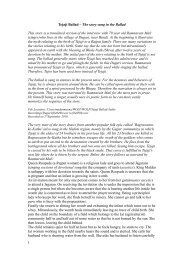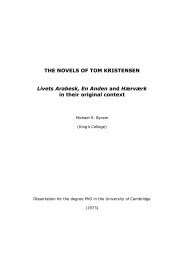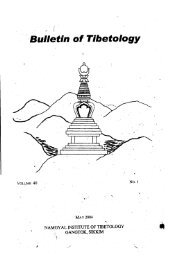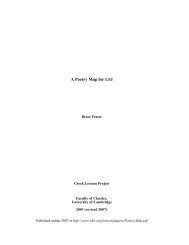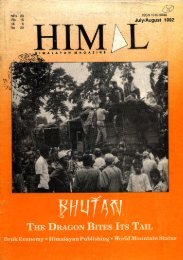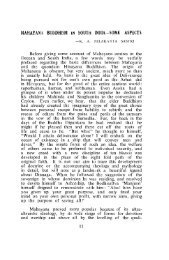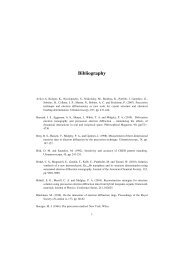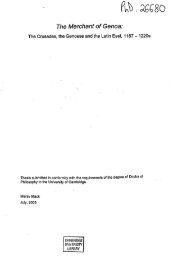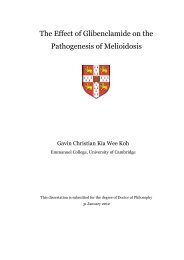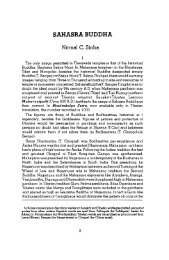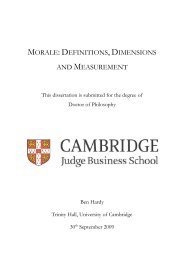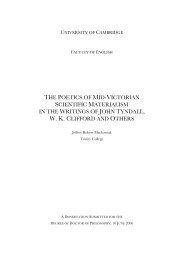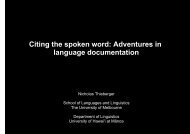Continuing Customs of Negotiation and Contestation in Bhutan
Continuing Customs of Negotiation and Contestation in Bhutan
Continuing Customs of Negotiation and Contestation in Bhutan
Create successful ePaper yourself
Turn your PDF publications into a flip-book with our unique Google optimized e-Paper software.
<strong>Cont<strong>in</strong>u<strong>in</strong>g</strong> <strong>Customs</strong> <strong>of</strong> <strong>Negotiation</strong> <strong>and</strong> <strong>Contestation</strong> <strong>in</strong><br />
<strong>Bhutan</strong><br />
Introduction<br />
219<br />
Adam Pa<strong>in</strong> <strong>and</strong> Deki Pema ∗∗∗∗<br />
A concern for the ma<strong>in</strong>tenance <strong>of</strong> traditional values <strong>and</strong> customs <strong>in</strong> the<br />
processes <strong>of</strong> modernisation with<strong>in</strong> <strong>Bhutan</strong> is evident <strong>in</strong> much <strong>of</strong><br />
<strong>Bhutan</strong>’s <strong>of</strong>ficial documentation. The fundamental importance given<br />
to the ma<strong>in</strong>tenance <strong>and</strong> foster<strong>in</strong>g <strong>of</strong> Buddhism, its beliefs <strong>and</strong><br />
associated <strong>in</strong>stitutions reflected <strong>in</strong> <strong>Bhutan</strong>’s rich culture, is constantly<br />
returned to <strong>and</strong> emphasized <strong>in</strong> commentary. Thus the establishment <strong>of</strong><br />
the Special Commission for Cultural Affairs <strong>in</strong> 1985 “is seen as a<br />
reflection <strong>of</strong> the great importance placed upon the preservation <strong>of</strong> the<br />
country’s unique <strong>and</strong> dist<strong>in</strong>ct religious <strong>and</strong> cultural traditions <strong>and</strong><br />
values, expressed <strong>in</strong> the customs, manners, language, dress, arts <strong>and</strong><br />
crafts which collectively def<strong>in</strong>e <strong>Bhutan</strong>’s national identity” (M<strong>in</strong>istry<br />
<strong>of</strong> Plann<strong>in</strong>g, 1996, p.193). Equally the publication <strong>of</strong> a manual on<br />
<strong>Bhutan</strong>ese Etiquette (Driglam Namzhag) by the National Library <strong>of</strong><br />
<strong>Bhutan</strong> was hopeful that it “would serve as a significant foundation <strong>in</strong><br />
the process <strong>of</strong> cultural preservation <strong>and</strong> cultural synthesis” (Publishers<br />
Forward, National Library, 1999).<br />
One str<strong>and</strong> <strong>of</strong> analysis that could be pursued concerns the very<br />
construct <strong>of</strong> “traditional” <strong>and</strong> what is constituted as “with<strong>in</strong>” or<br />
“without” that tradition. As Hobsbawm (1983) rem<strong>in</strong>ds us with<br />
respect to the British Monarchy, much <strong>of</strong> the ceremonial associated<br />
with it is <strong>of</strong> recent orig<strong>in</strong>. Equally national flags, national anthems <strong>and</strong><br />
even the nation state, are, as Hobsbawm would have it, “ <strong>in</strong>vented<br />
traditions” designed largely to “ <strong>in</strong>culcate certa<strong>in</strong> values <strong>and</strong> norms <strong>of</strong><br />
behaviour by repetition, which automatically implies cont<strong>in</strong>uity with<br />
∗ Research Fellow, School <strong>of</strong> Development Studies, University <strong>of</strong> East Anglia<br />
& Plann<strong>in</strong>g Officer, Policy & Plann<strong>in</strong>g Division, M<strong>in</strong>istry <strong>of</strong> Agriculture,<br />
Thimphu
<strong>Cont<strong>in</strong>u<strong>in</strong>g</strong> <strong>Customs</strong> <strong>of</strong> <strong>Negotiation</strong> <strong>and</strong> <strong>Contestation</strong> <strong>in</strong> <strong>Bhutan</strong><br />
the past” (op. cit p1). While it is clear that certa<strong>in</strong> emblems <strong>of</strong><br />
tradition with<strong>in</strong> <strong>Bhutan</strong> are <strong>of</strong> relatively recent orig<strong>in</strong> (e.g. the flag, the<br />
national anthem), there is also a strong core <strong>of</strong> traditional practices<br />
<strong>and</strong> cultural norms that stretch back <strong>in</strong>to history although the use to<br />
which they have been put may have varied over time.<br />
Much <strong>of</strong> the recent writ<strong>in</strong>g on <strong>Bhutan</strong> has focussed on the more<br />
formal <strong>and</strong> materially evident aspects <strong>of</strong> tradition <strong>and</strong> culture – the<br />
religious <strong>in</strong>stitutions <strong>and</strong> their ceremonies, the monarchy, architecture<br />
<strong>and</strong> textiles (see Aris, 1994; Myers & Bean, 1994; Schicklgruber &<br />
Pommaret). Aris’s paper <strong>of</strong> 1994 (Aris, 1994) on patterns <strong>of</strong> conflict,<br />
mediation <strong>and</strong> conciliation with<strong>in</strong> <strong>Bhutan</strong> is possibly the only writ<strong>in</strong>g<br />
on <strong>Bhutan</strong>, which looks at patterns <strong>of</strong> social <strong>in</strong>teraction, although<br />
primarily at the level <strong>of</strong> political (<strong>and</strong> military) conflict. His<br />
fasc<strong>in</strong>at<strong>in</strong>g paper on negotiation <strong>and</strong> mediation as customary<br />
<strong>Bhutan</strong>ese practices, <strong>and</strong> their embeddedness <strong>in</strong> Buddhist doctr<strong>in</strong>e,<br />
theocratic, legal 1 <strong>and</strong> political <strong>in</strong>stitutions is the start<strong>in</strong>g po<strong>in</strong>t <strong>of</strong> this<br />
paper.<br />
Historical Evidence<br />
While most <strong>of</strong> Aris’s examples relate to political <strong>and</strong> military disputes<br />
both between Tibet <strong>and</strong> <strong>Bhutan</strong> <strong>and</strong> with<strong>in</strong> <strong>Bhutan</strong>, he cites one<br />
example (op.cit. p14) <strong>of</strong> dispute between two rural communities <strong>of</strong><br />
Ura <strong>in</strong> Bumthang <strong>and</strong> Ngangla Kharchung <strong>in</strong> Mongar 2 over traditional<br />
graz<strong>in</strong>g rights with<strong>in</strong> Mongar. In this long runn<strong>in</strong>g dispute, the<br />
litigants have been <strong>in</strong> <strong>and</strong> out <strong>of</strong> court <strong>and</strong> through various processes<br />
<strong>of</strong> conciliation, all <strong>of</strong> which had failed to provide judgements that<br />
stuck. While Aris used this case to illustrate the process <strong>of</strong> mediation,<br />
what is also reveal<strong>in</strong>g about the dispute has been the endur<strong>in</strong>g<br />
capability <strong>of</strong> the people <strong>of</strong> Ngangla Kharchung to cont<strong>in</strong>ue to protest<br />
<strong>and</strong> dispute a court judgement that found aga<strong>in</strong>st them, a fact<br />
<strong>in</strong>dicat<strong>in</strong>g ‘the relative impotency <strong>of</strong> the state <strong>in</strong> settl<strong>in</strong>g (the) conflict’<br />
(op.cit p15). Other historical evidence supports an <strong>in</strong>terpretation <strong>of</strong> the<br />
limits <strong>of</strong> state power (<strong>and</strong> historically fractionated nature <strong>of</strong> the state)<br />
<strong>and</strong> the ability <strong>of</strong> rural communities to protest <strong>and</strong> to f<strong>in</strong>d means <strong>of</strong><br />
do<strong>in</strong>g so <strong>in</strong> a political system that has <strong>of</strong>ten held by outside<br />
commentators to be rigidly feudal.<br />
201
Journal <strong>of</strong> <strong>Bhutan</strong> Studies<br />
Karma Ura’s book The Hero With a Thous<strong>and</strong> Eyes (Ura, 1995) while<br />
subtitled a historical novel is <strong>in</strong> reality a th<strong>in</strong>ly disguised biography <strong>of</strong><br />
Dasho Sh<strong>in</strong>gkhar Lam. Sh<strong>in</strong>gkhar Lam was conscripted as a court<br />
servant <strong>of</strong> the second K<strong>in</strong>g <strong>of</strong> <strong>Bhutan</strong> <strong>in</strong> 1944, rose to the rank <strong>of</strong><br />
Deputy M<strong>in</strong>ister <strong>and</strong> Speaker <strong>of</strong> the National Assembly <strong>of</strong> <strong>Bhutan</strong><br />
under the third K<strong>in</strong>g <strong>and</strong> f<strong>in</strong>ally retired <strong>in</strong> 1985 dur<strong>in</strong>g the reign <strong>of</strong> the<br />
fourth K<strong>in</strong>g. His <strong>in</strong>volvement <strong>in</strong> the various stages <strong>of</strong> tax reform<br />
dur<strong>in</strong>g both the reign <strong>of</strong> the second <strong>and</strong> third K<strong>in</strong>gs provide the basis<br />
<strong>of</strong> details on taxation regimes <strong>in</strong> Chapter 8 <strong>of</strong> Ura’s book. This<br />
chapter, so far the only recently published source 3 to beg<strong>in</strong> to look at<br />
<strong>Bhutan</strong>’s rural economy prior to the 1950s provides evidence <strong>of</strong><br />
aspects <strong>of</strong> social economic relations between rulers <strong>and</strong> the ruled for<br />
at least for the early part <strong>of</strong> the 20 th century.<br />
The detail<strong>in</strong>g <strong>of</strong> the specifics (given by nature <strong>of</strong> the tax <strong>and</strong> by<br />
household type) <strong>of</strong> the taxes (primarily <strong>in</strong> k<strong>in</strong>d <strong>and</strong> <strong>in</strong> labour) overlies<br />
two broader features. The first is the multiplicity <strong>of</strong> taxation regimes<br />
that could be imposed accord<strong>in</strong>g to the relative strength or will <strong>of</strong> the<br />
local ruler or tax collector. Indeed part <strong>of</strong> the purpose <strong>of</strong> the tax<br />
reform exercise under the 3 rd K<strong>in</strong>g was precisely to impose a uniform<br />
taxation regime across the country (op.cit p139) <strong>and</strong> reduce where<br />
possible the taxes paid. As we will see later <strong>in</strong> the discussion on the<br />
records <strong>of</strong> the early meet<strong>in</strong>gs <strong>of</strong> the National Assembly this did not<br />
serve to remove various anomalies <strong>in</strong> the taxes paid. The second<br />
feature concerns the tax status <strong>of</strong> <strong>in</strong>dividual households with<strong>in</strong> a given<br />
taxation regime <strong>and</strong> whether they were regarded as full pay<strong>in</strong>g tax<br />
households (the threlpa or khep households whose tax (<strong>and</strong> social)<br />
status could be traced back to their ancestors role as patrons 4 <strong>of</strong> the<br />
Zhabdrung), the zurpa households that were relatively young<br />
households that paid partial taxes <strong>and</strong> the suma households who had<br />
protection under one <strong>of</strong> the aristocratic families <strong>and</strong> paid lower taxes<br />
than the other two groups. In addition there were both drab<br />
households under the protection <strong>of</strong> religious establishments who paid<br />
no taxes <strong>and</strong> serfs who belonged to richer households.<br />
What is reveal<strong>in</strong>g is the ability <strong>of</strong> households at times to contest <strong>and</strong><br />
change their tax status by play<strong>in</strong>g <strong>of</strong>f one taxation centre aga<strong>in</strong>st<br />
202
<strong>Cont<strong>in</strong>u<strong>in</strong>g</strong> <strong>Customs</strong> <strong>of</strong> <strong>Negotiation</strong> <strong>and</strong> <strong>Contestation</strong> <strong>in</strong> <strong>Bhutan</strong><br />
another. For example Upper Kheng broke away from the Dzongpon <strong>of</strong><br />
Zhemgang <strong>in</strong> the early part <strong>of</strong> the 20 th century <strong>and</strong> sought protection<br />
under Wangdichol<strong>in</strong>g Palace <strong>in</strong> Bumthang because <strong>of</strong> the labour<br />
burdens for dzong construction that were be<strong>in</strong>g imposed by the<br />
Dzongpon (Tenz<strong>in</strong> Rigden <strong>and</strong> Ugyen Pelgen, 1999 p47). Households<br />
might appeal over the head <strong>of</strong> their local lord <strong>in</strong> order to reduce tax<br />
dem<strong>and</strong>s, not always successfully. A number <strong>of</strong> kashos (written order)<br />
held by the descendants <strong>of</strong> the Chumi Zhelngo 5 illustrate these various<br />
po<strong>in</strong>ts (see Table 1).<br />
The first three documents illustrate some <strong>of</strong> the circumstances under<br />
which taxation might be relieved either by the immediate po<strong>in</strong>t <strong>of</strong><br />
taxation or by a higher authority. Documents (a) <strong>and</strong> (c) identify<br />
religious responsibilities or donations as grounds for tax relief.<br />
Document (b) is an agreement on ga<strong>in</strong><strong>in</strong>g protection from the Chumi<br />
Zhelngo.<br />
203
Journal <strong>of</strong> <strong>Bhutan</strong> Studies<br />
Table 1: Kashos held by Chumi Zhelngo 2<br />
Tax Exemptions<br />
(a) Kasho issued by Uygen Wangchuk (1 st K<strong>in</strong>g) exempt<strong>in</strong>g Dungdung<br />
households as suma households under the Chumi Zhelngo, from<br />
taxation on the wetl<strong>and</strong> as the Chumi Zhelngo had contributed relics<br />
to Punakha Dzong after it had been burnt down. Undated<br />
(b) Informal agreement between households <strong>of</strong> Koshila <strong>and</strong> Dungdung<br />
for the acquisition <strong>of</strong> suma status; each gave two langdos <strong>of</strong> wetl<strong>and</strong><br />
to the Chumi Zhelngo <strong>in</strong> exchange for protection <strong>and</strong> because <strong>of</strong> the<br />
fame <strong>of</strong> Pema L<strong>in</strong>gpa’s son <strong>and</strong> the many kashos from the<br />
Zhabdrung. Undated, possibly about 300 years ago dur<strong>in</strong>g the time<br />
<strong>of</strong> Pema L<strong>in</strong>gpa’s son<br />
(c) An exemption for Chumi Zhelngo <strong>and</strong> his drabs from pay<strong>in</strong>g butter<br />
tax on account <strong>of</strong> the three lhakhangs that he had to ma<strong>in</strong>ta<strong>in</strong>. Male<br />
Wood Tiger Year (1914?). Authority unknown.<br />
Ma<strong>in</strong>tenance / Confirmation <strong>of</strong> Taxation<br />
(a) Year <strong>of</strong> the Fire Monkey 20 th Day <strong>of</strong> the 1 st Month, issued by Desi<br />
Jigme S<strong>in</strong>gay (1896?)<br />
Each khep household <strong>in</strong> Dundung must pay 20 dreys <strong>of</strong> paddy to the<br />
Chumi Zhelngo.<br />
(b) Iron Mouse Year (1840/1900?) (apparently to the drabs <strong>of</strong> Chumi<br />
Zhelngo who had compla<strong>in</strong>ed <strong>of</strong> the services that they had to<br />
provide) - issued by a Desi?<br />
Chumi Zhelngo has been a very important seat <strong>of</strong> Terton Pema<br />
L<strong>in</strong>gpa’s son Dawa. Therefore the people should cont<strong>in</strong>ue to pay<br />
fodder <strong>and</strong> firewood taxes <strong>and</strong> also transport these loads to Tibet<br />
both <strong>in</strong> summer <strong>and</strong> w<strong>in</strong>ter. Similarly all other types <strong>of</strong> services that<br />
were <strong>of</strong>fered to the Zhelngo are to be cont<strong>in</strong>ued without rais<strong>in</strong>g any<br />
204
compla<strong>in</strong>ts.<br />
<strong>Cont<strong>in</strong>u<strong>in</strong>g</strong> <strong>Customs</strong> <strong>of</strong> <strong>Negotiation</strong> <strong>and</strong> <strong>Contestation</strong> <strong>in</strong> <strong>Bhutan</strong><br />
(c) Iron Pig Year, (1851?) issued by Jigme Wangchuk, Desi <strong>and</strong> also sent to<br />
16 households <strong>in</strong> Tsampa <strong>in</strong> Tibet<br />
Chumi Naktsang is allowed to carry out its salt trade <strong>in</strong> Tsampa <strong>and</strong><br />
Langtad as this was the practice over the last many decades. Therefore<br />
the people <strong>of</strong> Tsampa should not create any sort <strong>of</strong> disturbances that<br />
could affect the salt trade <strong>of</strong> the Zhelngo. Moreover henceforth the<br />
Zhelngo should be allowed to trade with the people <strong>of</strong> Lhalung, Dojong<br />
<strong>and</strong> Nyidey.<br />
(d) Earth Bird Year (1909) issued by the first k<strong>in</strong>g<br />
People <strong>of</strong> Chumi are responsible for transport<strong>in</strong>g sixteen yak loads <strong>of</strong><br />
Chumi Zhelngo to Tibet twice a year. They are also obliged to carry<br />
back whatever loads the Zhelngo wants to transport from Tibet. This<br />
responsibility was imposed by Zhabdrung Ngawang Namgyal himself<br />
<strong>and</strong> it to be cont<strong>in</strong>ued without rais<strong>in</strong>g any objections.<br />
(e) Iron Monkey Year, (1920) issued from Lame Gompa <strong>and</strong> issued to the<br />
people <strong>of</strong> Upper Choekoer with regard to the transportation <strong>of</strong> Chumi<br />
Zhelngo’s loads to Tibet.<br />
You have raised compla<strong>in</strong>ts <strong>and</strong> requested exemption. While you are<br />
exempted from the transportation <strong>of</strong> other types <strong>of</strong> loads you can never<br />
be exempted from the transportation <strong>of</strong> Chumi Zhelngo’s loads as there<br />
is a kasho from His Majesty comm<strong>and</strong><strong>in</strong>g the cont<strong>in</strong>uation <strong>of</strong> this<br />
service to the Zhelngo.<br />
The five documents listed under the Ma<strong>in</strong>tenance or Confirmation <strong>of</strong><br />
Taxes <strong>in</strong>dicates two aspects. First households could <strong>and</strong> did frequently<br />
raise requests (or “request exemption”, a phrase that has cont<strong>in</strong>ued <strong>in</strong><br />
use) to be relieved <strong>of</strong> taxes <strong>and</strong> second, such requests or compla<strong>in</strong>ts<br />
could <strong>of</strong>ten be rejected. The grounds for rejection are reveal<strong>in</strong>g.<br />
Obligations on grounds <strong>of</strong> support for religious <strong>in</strong>stitutions or<br />
customary support to religious <strong>in</strong>stitutions were without question to be<br />
205
Journal <strong>of</strong> <strong>Bhutan</strong> Studies<br />
ma<strong>in</strong>ta<strong>in</strong>ed, although contributions to religious <strong>in</strong>stitutions could<br />
provide grounds for subsequent relief. In addition, practices that could<br />
claim tradition or custom (see (c) on the salt trade) or authority (a<br />
kasho from the K<strong>in</strong>g) could not be relieved.<br />
If requests for the relief <strong>of</strong> taxation burdens were rejected, <strong>and</strong> the<br />
taxes were found to be <strong>in</strong>tolerable, <strong>in</strong> extremis households or even<br />
whole villages could migrate. There are examples <strong>of</strong> households from<br />
central <strong>Bhutan</strong> migrated eastwards to Trashigang <strong>in</strong> order to escape<br />
taxation burdens from central <strong>and</strong> eastern <strong>Bhutan</strong> <strong>and</strong> ga<strong>in</strong>ed suma<br />
status where they settled (Interview with Dasho Tenz<strong>in</strong> Dorji,<br />
Trashigang, September 21 st . 1999). Van Driem (1992, p24) accounts<br />
for the settlement <strong>of</strong> Monpas <strong>in</strong> the village <strong>of</strong> Reti on the eastern<br />
slopes <strong>of</strong> the Black Mounta<strong>in</strong>s as an escape from Rukha on the<br />
western side <strong>of</strong> the Black mounta<strong>in</strong>s <strong>and</strong> corvee labour impositions <strong>of</strong><br />
carry<strong>in</strong>g tea from the south <strong>of</strong> Wangdi Phodrang dur<strong>in</strong>g the time <strong>of</strong><br />
the first K<strong>in</strong>g. The settlement <strong>of</strong> households from Kheng (Zhemgang)<br />
<strong>in</strong> Dagana dur<strong>in</strong>g the early 20 th century can also be partly accounted<br />
for by this (Adam Pa<strong>in</strong> <strong>and</strong> Deki Pema, Field Notes, February 2000).<br />
Evidence from the National Assembly Records<br />
Debate <strong>and</strong> contestation over taxation cont<strong>in</strong>ued <strong>in</strong>to a more public<br />
forum once the National Assembly was established <strong>in</strong> 1952 <strong>and</strong><br />
Annex 1 conta<strong>in</strong>s a selection <strong>of</strong> resolutions related to tax adopted by<br />
the National Assembly between 1952 <strong>and</strong> 1968. While the resolutions<br />
shed little direct light on the mode <strong>of</strong> br<strong>in</strong>g<strong>in</strong>g such items to the<br />
agenda, the conduct <strong>of</strong> the discussion <strong>and</strong> debate <strong>and</strong> the methods <strong>and</strong><br />
protocol <strong>of</strong> resolution, the range <strong>and</strong> specificity <strong>of</strong> the topics <strong>and</strong> the<br />
fact that these issues were brought up for discussion at all is <strong>in</strong>dicative<br />
<strong>of</strong> the fact that such matters were seen to be legitimate matters for<br />
debate.<br />
The various resolutions shed light on the range <strong>of</strong> taxes that had been<br />
historically imposed <strong>and</strong> the variability <strong>of</strong> those taxes between<br />
locations. In addition to gra<strong>in</strong> taxes (see Session (S) 19, resolution (R)<br />
35) taxes were paid <strong>in</strong> the form <strong>of</strong> salt (S17, R35; S17, R11), grass<br />
(S1,R1c), labour (S1,R1d & e), butter (S16,R13), bamboo (S19,R10),<br />
206
<strong>Cont<strong>in</strong>u<strong>in</strong>g</strong> <strong>Customs</strong> <strong>of</strong> <strong>Negotiation</strong> <strong>and</strong> <strong>Contestation</strong> <strong>in</strong> <strong>Bhutan</strong><br />
butter conta<strong>in</strong>ers (S19,R9), <strong>in</strong>cense (S19,R18), leather bags (S1,R6),<br />
paper (S14,R8), cloth (S14,R7), wool (S20,R13), baskets <strong>and</strong> buckets<br />
(S19,R24), sh<strong>in</strong>gles for ro<strong>of</strong><strong>in</strong>g (S22, R2) <strong>and</strong> timber (S20,R21).<br />
A number <strong>of</strong> the debates were concerned with the resolution <strong>of</strong> what<br />
were seen to be <strong>in</strong>equities <strong>in</strong> terms <strong>of</strong> tax payment. Thus <strong>in</strong> Session 1<br />
(R1d) efforts were made to ensure that the labour for driv<strong>in</strong>g the<br />
K<strong>in</strong>gs cattle dur<strong>in</strong>g transhumance was distributed equally between<br />
communities. Butter taxes (S16, R13) were reformed so that taxes<br />
were not imposed on those who had no cattle <strong>and</strong> to ensure that cash<br />
payment <strong>in</strong> lieu <strong>of</strong> butter payment was st<strong>and</strong>ardised (S20, R23)<br />
between Thimphu <strong>and</strong> other dzongkhags (districts). Double taxation<br />
on graz<strong>in</strong>g l<strong>and</strong> (S26, R6) was raised (although it is not stated how<br />
this was resolved).<br />
Many <strong>of</strong> the agenda items raised were concerned with ga<strong>in</strong><strong>in</strong>g a<br />
reduction <strong>in</strong> the amount <strong>of</strong> taxes to be paid. Thus the amount <strong>of</strong> grass<br />
to be paid as tax was reduced for the people <strong>of</strong> Tongsa (S1, R1c), the<br />
amount <strong>of</strong> salt tax paid by the Layaps to Punakha <strong>and</strong> Gasa was<br />
reduced (S17, R11), the people <strong>of</strong> Phobji supplied a permanent box<br />
for butter storage <strong>in</strong>stead <strong>of</strong> pay<strong>in</strong>g annually 120 butter conta<strong>in</strong>ers<br />
(S19, R9), the supply <strong>of</strong> bamboo mats from two communities <strong>in</strong><br />
Wangdi was reduced from 25 to 5 (S19, R10) <strong>and</strong> taxes on Tseri l<strong>and</strong><br />
were halved (S28, R17).<br />
In other cases the payment <strong>of</strong> certa<strong>in</strong> taxes was exempted altogether.<br />
Thus the people <strong>of</strong> Dagana were exempted from supply<strong>in</strong>g the raw<br />
material for <strong>in</strong>cense (S19, R18), the paddy tax paid on l<strong>and</strong> belong<strong>in</strong>g<br />
to the Central Monk Body <strong>in</strong> Gasa was abolished on the grounds that<br />
the l<strong>and</strong> itself had been washed away more than 50 years ago (a<br />
reveal<strong>in</strong>g fact which does not expla<strong>in</strong> why the tax cont<strong>in</strong>ued to be<br />
paid) <strong>and</strong> farmers had still been pay<strong>in</strong>g the tax (S19, R35) <strong>and</strong> the<br />
obligation to supply planks by the people <strong>of</strong> Goen Shari to Punakha<br />
Dzong was abolished.<br />
Request for relief <strong>of</strong> taxation burdens were not always met. The<br />
request to substitute a lower quality cloth as tax payment by the<br />
people <strong>of</strong> Tashigang was not agreed to (S14, R7); the attempt by the<br />
207
Journal <strong>of</strong> <strong>Bhutan</strong> Studies<br />
people <strong>of</strong> Gasa to be excused the supply <strong>of</strong> sh<strong>in</strong>gles on the basis <strong>of</strong><br />
kashos held from both the 2 nd <strong>and</strong> 3 rd K<strong>in</strong>g, was not agreed to on<br />
account <strong>of</strong> objections by the people <strong>of</strong> Shar <strong>and</strong> Punakha who argued<br />
that the sh<strong>in</strong>gle labour tax was be<strong>in</strong>g raised under a different taxation<br />
system (S22, R2). The <strong>in</strong>itial refusal by the Assembly to accept a<br />
request for the exemption <strong>of</strong> a potato tax by the people <strong>of</strong> Chapcha,<br />
Kheng <strong>and</strong> Samdrup Jongkhar (S25, R6) was subsequently overturned<br />
when the matter was brought back to a later assembly (S26, R5) <strong>and</strong><br />
the request brought by a wider constituency.<br />
This latter debate on potato tax raises a number <strong>of</strong> broader issues.<br />
Prior to the National Assembly establishment negotiation on taxation<br />
had been very much a local debate carried on between the taxpayer<br />
<strong>and</strong> the local tax authority <strong>and</strong> the visibility <strong>of</strong> excess or exempted tax<br />
was limited. Once the debate was brought to a new <strong>and</strong> larger forum<br />
the knowledge base on which taxes could be compared was <strong>of</strong> course<br />
widened but equally the chances for <strong>in</strong>dividual negotiation reduced<br />
because there were others to ensure that equity was ma<strong>in</strong>ta<strong>in</strong>ed.<br />
Indeed with the <strong>in</strong>troduction <strong>of</strong> a monetary form <strong>of</strong> taxation from the<br />
1960s onwards the debates on taxes reduced substantially as other<br />
State <strong>in</strong>terventions, most notably the Forest Act <strong>of</strong> 1969 <strong>and</strong> the L<strong>and</strong><br />
Act <strong>of</strong> 1978 were <strong>in</strong>troduced. 6<br />
The 1969 Forest Act <strong>and</strong> Debates <strong>in</strong> the National Assembly<br />
The <strong>Bhutan</strong> Forest Act <strong>of</strong> 1969 was the first major act to be<br />
<strong>in</strong>troduced after the creation <strong>of</strong> the Thrimzhung Chhenmo (Supreme<br />
Laws) <strong>of</strong> 1957. It <strong>in</strong> effect nationalised all forestl<strong>and</strong> <strong>and</strong> restricted<br />
access to or regulated use <strong>of</strong> forest products such as timber, pasture<br />
<strong>and</strong> other forest produce. 7 Further it reserved the right to the absolute<br />
ownership <strong>of</strong> trees, timber <strong>and</strong> other forest produce on private l<strong>and</strong><br />
(The <strong>Bhutan</strong> Forest Act 1969, Chapter III, Section 10).<br />
From 1969 onwards it is evident from the National Assembly<br />
resolutions that the scope <strong>and</strong> restrictions <strong>of</strong> this Act were under<br />
constant debate. Thus <strong>in</strong> Session 31 (1969) resolution 2 established<br />
the rights <strong>of</strong> villagers to use l<strong>and</strong>s with<strong>in</strong> a radius <strong>of</strong> 2 miles <strong>of</strong> the<br />
208
<strong>Cont<strong>in</strong>u<strong>in</strong>g</strong> <strong>Customs</strong> <strong>of</strong> <strong>Negotiation</strong> <strong>and</strong> <strong>Contestation</strong> <strong>in</strong> <strong>Bhutan</strong><br />
village for graz<strong>in</strong>g (<strong>and</strong> re-debated <strong>in</strong> S32, R21). Rights <strong>of</strong> use on<br />
soksh<strong>in</strong>g (l<strong>and</strong> from which leaf litter is collected) that had been<br />
registered <strong>in</strong> <strong>in</strong>dividual thrams (l<strong>and</strong> register) have been constantly<br />
contested <strong>in</strong> the National Assembly. The dem<strong>and</strong>s for the above<br />
article to be amended (to allow for the rights to fell timber without<br />
taxation on l<strong>and</strong> registered <strong>in</strong> one’s own thram) have been cont<strong>in</strong>ually<br />
resisted (see S32, R18; S45, R3). Ultimately however (R48, S1) rights<br />
to the free use <strong>of</strong> timber from trees grow<strong>in</strong>g on registered l<strong>and</strong> by the<br />
owner were ga<strong>in</strong>ed <strong>and</strong> established through clauses 6 <strong>and</strong> 7 <strong>in</strong> Chapter<br />
III <strong>of</strong> the L<strong>and</strong> Act although the Forest Act cont<strong>in</strong>ued to govern the<br />
access to trees on privately registered tsamdo (graz<strong>in</strong>g l<strong>and</strong>) <strong>and</strong><br />
soksh<strong>in</strong>g. This compromise did not stop further unsuccessful attempts<br />
to rega<strong>in</strong> timber rights at a subsequent Assembly meet<strong>in</strong>g (S49, R5).<br />
Rights to other forest produce were reclaimed. Thus exemption from<br />
taxation from the use <strong>of</strong> bamboo grow<strong>in</strong>g on pasture l<strong>and</strong> or tseri<br />
(l<strong>and</strong> cultivated under fallow<strong>in</strong>g systems) registered <strong>in</strong> the sathram,<br />
for feed<strong>in</strong>g livestock was ga<strong>in</strong>ed (S32, R20) although the right to levy<br />
tax on bamboo used for ro<strong>of</strong><strong>in</strong>g was ma<strong>in</strong>ta<strong>in</strong>ed at that time. However<br />
later the right to use bamboo for house construction <strong>and</strong> domestic<br />
purposes without taxation was also rega<strong>in</strong>ed (S38, R6). Similarly the<br />
rights to extract tree juice for polish<strong>in</strong>g <strong>and</strong> domestic purposes without<br />
taxation was rega<strong>in</strong>ed, subject to the permit from the Dzongda (S32,<br />
R26).<br />
More general dissatisfaction with the regulation <strong>of</strong> the use <strong>of</strong> pasture<br />
l<strong>and</strong> on which owners paid taxes <strong>and</strong> costs by the Forest Department<br />
emerged later (S45, R4) where it was argued that the Forest<br />
Department had failed to recognize the rights <strong>of</strong> pasture owners on<br />
their own l<strong>and</strong>s. The decision for an <strong>in</strong>vestigation to report back at the<br />
next session led to the establishment <strong>of</strong> a set <strong>of</strong> draft Rules <strong>and</strong><br />
Regulations on pasture l<strong>and</strong> which were then <strong>in</strong>corporated <strong>in</strong>to the<br />
L<strong>and</strong> Act.<br />
It is not the purpose <strong>of</strong> this paper to follow through the tangled history<br />
<strong>of</strong> debate <strong>and</strong> contention on the scope <strong>and</strong> remit <strong>of</strong> the Forest Act <strong>and</strong><br />
access to <strong>and</strong> use <strong>of</strong> l<strong>and</strong> covered both by this Act <strong>and</strong> the L<strong>and</strong> Act.<br />
The important po<strong>in</strong>t to be made is that even with<strong>in</strong> a formal<br />
209
Journal <strong>of</strong> <strong>Bhutan</strong> Studies<br />
<strong>in</strong>stitutional sett<strong>in</strong>g <strong>of</strong> the National Assembly rights to access <strong>and</strong> use<br />
<strong>of</strong> resources were cont<strong>in</strong>ually be<strong>in</strong>g debated, renegotiated <strong>and</strong><br />
contested.<br />
The m<strong>in</strong>utes <strong>of</strong> the National Assembly <strong>of</strong> course give no flavour <strong>of</strong><br />
the debate or detail as to the positions adopted by contend<strong>in</strong>g <strong>in</strong>terests<br />
<strong>in</strong> the discussion. Nor <strong>of</strong> course do formal agreements at this level<br />
necessarily reflect outcomes <strong>in</strong> the practice <strong>of</strong> resource use at the<br />
village level. But the National Assembly has not been the only<br />
recourse that the rural population has to renegotiate rights <strong>of</strong> use <strong>and</strong><br />
access to resources <strong>and</strong> traditional avenues <strong>of</strong> recourse have also been<br />
ma<strong>in</strong>ta<strong>in</strong>ed.<br />
A read<strong>in</strong>g <strong>of</strong> the Manual <strong>of</strong> Forest Orders (Department <strong>of</strong> Forestry,<br />
1987) shows that direct appeal to the K<strong>in</strong>g could also establish (or reestablish)<br />
rights <strong>of</strong> use. Examples <strong>in</strong>clude the follow<strong>in</strong>g:<br />
- A Royal Comm<strong>and</strong> <strong>of</strong> 1975 to reduce by 50% the royalty on<br />
timber used for the construction <strong>of</strong> Wooden Bridges <strong>and</strong> Wooden<br />
Channels for Irrigation (Adm<strong>in</strong>istrative Orders p.2)<br />
- An Office Order <strong>of</strong> 1978 based on a Royal Comm<strong>and</strong> allow<strong>in</strong>g<br />
villagers to collect bamboo <strong>and</strong> cane free <strong>of</strong> royalty for the<br />
purposes <strong>of</strong> h<strong>and</strong>icraft production (Adm<strong>in</strong>istrative Order p.16)<br />
- A Sanction Order <strong>of</strong> 1979 allow<strong>in</strong>g <strong>in</strong>habitants <strong>of</strong> Laya, L<strong>in</strong>gshi<br />
<strong>and</strong> Lunana to collect <strong>in</strong>cense free <strong>of</strong> royalty (Adm<strong>in</strong>istrative<br />
Order p.26)<br />
- A Sanction Order <strong>of</strong> 1980 waiv<strong>in</strong>g the forest royalty <strong>and</strong> sales tax<br />
on the collection <strong>and</strong> sale <strong>of</strong> lac (Adm<strong>in</strong>istrative Order p.29)<br />
- An Office Order <strong>of</strong> 1985 based on Royal approval for exemption<br />
<strong>of</strong> royalty on timber for house construction for the <strong>in</strong>habitants <strong>of</strong><br />
L<strong>in</strong>gshi Dungkhag (Adm<strong>in</strong>istrative Order p.103)<br />
Space does not permit a detailed discussion <strong>of</strong> the 1978 l<strong>and</strong> act <strong>and</strong><br />
the negotiation that has arisen with respect to various categories <strong>of</strong><br />
l<strong>and</strong> use, <strong>in</strong>clusion <strong>of</strong> l<strong>and</strong> with<strong>in</strong> <strong>and</strong> outside l<strong>and</strong> ceil<strong>in</strong>gs, taxation<br />
rates accord<strong>in</strong>g to altitude <strong>and</strong> so forth. Suffice it to say that the<br />
National Assembly resolutions read <strong>in</strong> conjunction with the guidel<strong>in</strong>es<br />
<strong>of</strong> the M<strong>in</strong>istry <strong>of</strong> Home Affairs (Procedures on the L<strong>and</strong> Registration<br />
210
<strong>Cont<strong>in</strong>u<strong>in</strong>g</strong> <strong>Customs</strong> <strong>of</strong> <strong>Negotiation</strong> <strong>and</strong> <strong>Contestation</strong> <strong>in</strong> <strong>Bhutan</strong><br />
<strong>and</strong> Transaction System, 1998; Guidel<strong>in</strong>es on the New Sathram<br />
Compilation, 1998) provide a similar picture <strong>of</strong> debate <strong>and</strong> negotiation<br />
over the mean<strong>in</strong>g, <strong>in</strong>terpretation <strong>and</strong> application <strong>of</strong> the L<strong>and</strong> Act.<br />
Compet<strong>in</strong>g Authorities <strong>and</strong> Rights <strong>of</strong> Recourse<br />
Reference back to Annex 1 (<strong>and</strong> discussed above) supplies a case<br />
where different views on the scope <strong>and</strong> jurisdiction <strong>of</strong> kashos were<br />
debated. In Session 22 under resolution 2, the jurisdiction <strong>of</strong> kashos<br />
issued by the 2 nd <strong>and</strong> 3 rd K<strong>in</strong>gs <strong>and</strong> held by the public <strong>of</strong> Gasa was<br />
debated. While the Gasaps (people <strong>of</strong> Gasa) held that these kashos<br />
exempted them from the supply <strong>of</strong> sh<strong>in</strong>gles to Punakha Dzong, this<br />
<strong>in</strong>terpretation was challenged by others on the grounds that new<br />
ground rules now governed the supply <strong>of</strong> sh<strong>in</strong>gles <strong>and</strong> that these<br />
superseded the application <strong>of</strong> the earlier kashos. The National<br />
Assembly upheld this challenge.<br />
Elsewhere (1970) <strong>in</strong> the National Assembly the issue <strong>of</strong> different<br />
sources <strong>of</strong> authority <strong>in</strong> relation to kashos also emerged <strong>and</strong> was<br />
addressed:<br />
‘It was observed that the practice <strong>of</strong> some rich people <strong>in</strong> certa<strong>in</strong><br />
Dzongkhags <strong>of</strong> produc<strong>in</strong>g Kashos from various dignitaries <strong>and</strong><br />
thereby excus<strong>in</strong>g themselves from Dzong renovation works was<br />
caus<strong>in</strong>g great problems to the people. As such it was decided that<br />
henceforth only those produc<strong>in</strong>g the Kasho <strong>of</strong> His Majesty the K<strong>in</strong>g<br />
would be exempted from such works. In this connection, His Majesty<br />
the K<strong>in</strong>g was pleased to issue a Kasho <strong>in</strong>validat<strong>in</strong>g the other Kashos<br />
issued by various dignitaries. The Assembly endorsed the move’ (S23,<br />
R37).<br />
Similarly it is evident from the Royal Comm<strong>and</strong> issued <strong>in</strong> 1984<br />
(Manual <strong>of</strong> Forest Orders, 1987 p11) stat<strong>in</strong>g “that no l<strong>and</strong> could be<br />
allocated by anybody except His Majesty” that prior to this date there<br />
had been various sources <strong>of</strong> authority for ga<strong>in</strong><strong>in</strong>g access to l<strong>and</strong>.<br />
Indeed (Interview, Dasho Tshewang Penjor, Paro, January 2000 -<br />
Adam Pa<strong>in</strong> <strong>and</strong> Deki Pema) it appears that dur<strong>in</strong>g the 1960 <strong>and</strong><br />
211
Journal <strong>of</strong> <strong>Bhutan</strong> Studies<br />
possibly <strong>in</strong>to the 1970 dur<strong>in</strong>g the whole process <strong>of</strong> l<strong>and</strong> registration<br />
<strong>and</strong> taxation reform, district level <strong>of</strong>ficials primarily gups (elected<br />
representatives at the geog (block) level <strong>and</strong> dzongdas (district<br />
adm<strong>in</strong>istrators) as well as central level <strong>of</strong>ficials had asserted rights<br />
(<strong>and</strong> thus authority) <strong>in</strong> the process <strong>of</strong> l<strong>and</strong> allocation. Evidence<br />
therefore at least <strong>in</strong>to the 1980s <strong>of</strong> multiple authorities with differ<strong>in</strong>g<br />
jurisdictions, all <strong>of</strong> which might provide room for manoeuvre for<br />
<strong>in</strong>dividual households.<br />
The issu<strong>in</strong>g <strong>of</strong> kashos is l<strong>in</strong>ked to a traditional right 8 to seek<br />
protection, assistance <strong>and</strong> relief (kidu) whereby <strong>in</strong>dividual households<br />
could seek help from both government <strong>of</strong>ficials <strong>and</strong> the K<strong>in</strong>g. Indeed<br />
the Home M<strong>in</strong>ister was until 1998 known as the Kidu Lyonpo. The<br />
seek<strong>in</strong>g <strong>of</strong> kidu from the K<strong>in</strong>g is an established <strong>and</strong> commonly<br />
exercised right <strong>and</strong> <strong>in</strong> the matter <strong>of</strong> l<strong>and</strong> allocation alone, substantial<br />
areas <strong>of</strong> l<strong>and</strong> was given to <strong>in</strong>dividual households by the present k<strong>in</strong>g<br />
between dur<strong>in</strong>g his reign (L<strong>and</strong> Records Office, M<strong>in</strong>istry <strong>of</strong> Home<br />
Affairs,) a tradition <strong>and</strong> exercise <strong>of</strong> right that can be traced back to the<br />
civil rulers (Desi) that predate the establishment <strong>of</strong> the monarchy.<br />
Kidu is also sought for assistance <strong>in</strong> matters <strong>of</strong> debt, particularly with<br />
formal <strong>in</strong>stitutions, <strong>and</strong> domestic disaster.<br />
Summary Discussion<br />
The emphasis <strong>of</strong> this paper <strong>in</strong> its description has been on the<br />
<strong>in</strong>teractions between <strong>in</strong>dividual households or communities, <strong>and</strong><br />
formal <strong>in</strong>stitutions <strong>in</strong> <strong>Bhutan</strong>, largely because that is where the written<br />
evidence lies. Fieldwork dur<strong>in</strong>g the last year (Adam Pa<strong>in</strong> <strong>and</strong> Deki<br />
Pema, Unpublished Field Notes) <strong>in</strong>dicate that patterns <strong>of</strong> social<br />
<strong>in</strong>teraction between rural households, with<strong>in</strong> <strong>and</strong> between different<br />
villages as well as between community <strong>and</strong> local authority are<br />
unsurpris<strong>in</strong>gly, deep <strong>in</strong> processes <strong>of</strong> negotiation <strong>and</strong> dispute. Evidence<br />
has been found <strong>of</strong> processes <strong>of</strong> renegotiation over access to common<br />
property resources <strong>of</strong> leaf litter, graz<strong>in</strong>g <strong>and</strong> forest produce both<br />
between <strong>and</strong> with<strong>in</strong> villages. Social networks that facilitate such<br />
<strong>in</strong>teraction are dense <strong>and</strong> lengthy. Some are sufficiently formalised to<br />
have ga<strong>in</strong>ed a recognised status, such as the nep system 9 , which is<br />
essentially a form <strong>of</strong> fictive k<strong>in</strong>ship, which allows households to lay<br />
212
<strong>Cont<strong>in</strong>u<strong>in</strong>g</strong> <strong>Customs</strong> <strong>of</strong> <strong>Negotiation</strong> <strong>and</strong> <strong>Contestation</strong> <strong>in</strong> <strong>Bhutan</strong><br />
claim or access to shelter, resources <strong>and</strong> other networks <strong>in</strong> different<br />
locations. Others, <strong>of</strong>ten mediated by k<strong>in</strong>ship or community identity,<br />
allow households to lay claim to assistance or resources outside their<br />
immediate physical environment.<br />
What does all this evidence <strong>of</strong> negotiation about resources amount to?<br />
The thread or patterns <strong>of</strong> negotiation that are evident from historical<br />
times to the present are a consistent representation <strong>of</strong> a dist<strong>in</strong>ctive<br />
pattern or custom <strong>of</strong> <strong>in</strong>teraction. They are statements about rights <strong>and</strong><br />
also about obligations. They are about cultural practices <strong>and</strong> power<br />
relations which as Berry (1993) puts it are neither separate, imitative<br />
or distortions <strong>of</strong> (as respectively structural <strong>and</strong> neo-classical economic<br />
theories would argue) economic activities but are a triad <strong>of</strong> closely<br />
<strong>in</strong>terrelated dimensions <strong>of</strong> social processes.<br />
The contract drawn between Zhabdrung Ngawang Namgyal <strong>and</strong><br />
between those who provided <strong>of</strong>fer<strong>in</strong>gs <strong>in</strong> the 17 century (Aris, 1986)<br />
<strong>and</strong> on which the taxation system was subsequently built was <strong>of</strong> a<br />
relationship between the patrons (the term used to describe those who<br />
supported the monastic <strong>in</strong>stitutions) whose material support to the<br />
religious <strong>and</strong> ultimately state <strong>in</strong>stitutions, was reciprocated with<br />
spiritual (<strong>and</strong> <strong>in</strong> times <strong>of</strong> <strong>in</strong>dividual need, material as well) guidance<br />
<strong>and</strong> support. While the contract was not one from which <strong>in</strong>dividuals<br />
could easily withdraw, <strong>and</strong> hence the <strong>in</strong>stances <strong>of</strong> migration described<br />
earlier <strong>in</strong> the paper, details could clearly be discussed or contested if<br />
local authorities at times were seen to exert or place unreasonable<br />
dem<strong>and</strong>s. L<strong>and</strong> however as an asset related more to social <strong>and</strong> cultural<br />
position <strong>and</strong> was rarely an asset for accumulation. Indicative <strong>of</strong> this<br />
fact is that l<strong>and</strong> ownership <strong>in</strong> <strong>Bhutan</strong> rema<strong>in</strong>s relatively egalitarian 10 <strong>in</strong><br />
terms <strong>of</strong> distribution <strong>of</strong> l<strong>and</strong> ownership <strong>in</strong> contrast with other Asian<br />
countries (Ura, 1993).<br />
But <strong>in</strong>stitutional sett<strong>in</strong>gs with<strong>in</strong> which negotiation has taken place<br />
have changed <strong>and</strong> <strong>in</strong>fluenced the substance <strong>of</strong> discussion, just as the<br />
debate has changed the <strong>in</strong>stitution itself. One cannot assume that<br />
negotiation about, for example, access to l<strong>and</strong> <strong>and</strong> payment <strong>of</strong> taxes<br />
addresses the same substantive issues now as it did <strong>in</strong> the past. The<br />
<strong>in</strong>stitutional position <strong>and</strong> authority <strong>of</strong> the 3 rd K<strong>in</strong>g was very different<br />
213
Journal <strong>of</strong> <strong>Bhutan</strong> Studies<br />
from that <strong>of</strong> the 2 nd K<strong>in</strong>g <strong>and</strong> new formal <strong>in</strong>stitutions such as the<br />
National Assembly came <strong>in</strong>to existence <strong>in</strong> the 1950s. The National<br />
Assembly was used as a forum to negotiate <strong>and</strong> contest taxes <strong>in</strong> k<strong>in</strong>d<br />
<strong>and</strong> its existence allowed a different scope to that debate than had<br />
existed previously. In turn the Forest Act <strong>of</strong> 1969 which emerged out<br />
<strong>of</strong> a modern government <strong>in</strong>stitution, <strong>and</strong> which probably owes much<br />
<strong>in</strong> objectives, style <strong>and</strong> content to Indian Forestry Acts was a step by<br />
government to redef<strong>in</strong>e access to resources. That it was contested both<br />
with<strong>in</strong> formal <strong>in</strong>stitutional sett<strong>in</strong>gs <strong>and</strong> <strong>in</strong> practice is hardly surpris<strong>in</strong>g<br />
<strong>and</strong> is well documented <strong>and</strong> this has led to some extent to<br />
modifications. Indeed it rema<strong>in</strong>s one <strong>of</strong> the more contentious pieces <strong>of</strong><br />
legislation <strong>and</strong> the mid-term review <strong>of</strong> the 8 th Five Year Plan by the<br />
Plann<strong>in</strong>g Commission was critical <strong>of</strong> the way <strong>in</strong> which it had<br />
imp<strong>in</strong>ged on the livelihoods <strong>of</strong> <strong>in</strong>dividuals.<br />
Equally the l<strong>and</strong> act <strong>of</strong> 1979, coupled with the monetization <strong>of</strong> taxes<br />
<strong>and</strong> the gradual open<strong>in</strong>g out <strong>of</strong> the economy to market forces,<br />
redef<strong>in</strong>ed both the social <strong>and</strong> economic nature <strong>of</strong> l<strong>and</strong> as an asset. It<br />
has rema<strong>in</strong>ed highly disputed although the nature <strong>of</strong> the disputes to do<br />
with l<strong>and</strong> use <strong>and</strong> l<strong>and</strong> area are different than from before, <strong>and</strong> <strong>in</strong> all<br />
probability will be subject to change <strong>in</strong> the near future.<br />
Social networks then are a feature <strong>of</strong> <strong>Bhutan</strong>ese society <strong>and</strong><br />
unsurpris<strong>in</strong>gly so, <strong>in</strong> such a small country. They permeate <strong>and</strong> fuse<br />
both the formal <strong>and</strong> <strong>in</strong>formal <strong>in</strong>stitutions. They allow for constant<br />
transactions <strong>and</strong> manoeuvre, which are <strong>of</strong>ten open-ended; they are a<br />
key part <strong>of</strong> <strong>Bhutan</strong>’s culture, <strong>of</strong> <strong>in</strong>ternal power relations <strong>and</strong> ultimately<br />
<strong>of</strong> economic activity as well.<br />
Acknowledgements<br />
It is our pleasure to acknowledge the <strong>in</strong>terest, assistance <strong>and</strong><br />
comments that have been made on earlier drafts <strong>of</strong> this paper by<br />
Françoise Pommaret, Nicholas Rhodes <strong>and</strong> Stefan Preisner. The<br />
authors are grateful to Lyonpo K<strong>in</strong>zang Dorji, M<strong>in</strong>istry <strong>of</strong> Agriculture,<br />
Royal Government <strong>of</strong> <strong>Bhutan</strong> for his support <strong>and</strong> <strong>in</strong>terest dur<strong>in</strong>g the<br />
field research. The assistance <strong>of</strong> Dasho Tashi Phuntsog, Secretary <strong>of</strong><br />
the National Assembly <strong>and</strong> the Secretariat <strong>in</strong> provid<strong>in</strong>g access to the<br />
resolutions <strong>of</strong> the National Assembly sessions was greatly<br />
214
<strong>Cont<strong>in</strong>u<strong>in</strong>g</strong> <strong>Customs</strong> <strong>of</strong> <strong>Negotiation</strong> <strong>and</strong> <strong>Contestation</strong> <strong>in</strong> <strong>Bhutan</strong><br />
appreciated. We are pleased to acknowledge the formal approval for<br />
the research, on which the Royal Government <strong>of</strong> <strong>Bhutan</strong> bases this<br />
paper.<br />
Adam Pa<strong>in</strong> was assisted by a grant from the Frederick Williamson<br />
Memorial Trust Fund, University <strong>of</strong> Cambridge dur<strong>in</strong>g this study.<br />
Deki Pema thanks the <strong>Bhutan</strong> Trust Fund for Environmental<br />
Conservation for a grant to cover time for data analysis <strong>and</strong> draft<strong>in</strong>g <strong>in</strong><br />
the UK. Both authors are grateful to Dr. Pema Gyamtsho, Head <strong>of</strong> the<br />
Policy <strong>and</strong> Plann<strong>in</strong>g Division, M<strong>in</strong>istry <strong>of</strong> Agriculture for his support<br />
to the research <strong>and</strong> provid<strong>in</strong>g assistance dur<strong>in</strong>g the course <strong>of</strong><br />
fieldwork.<br />
Bibliography<br />
Aris, M (1986). Sources for the History <strong>of</strong> <strong>Bhutan</strong>. <strong>Bhutan</strong> Legal Code<br />
<strong>of</strong> 1729, Part 5, Vienna. Arbeitsoresl fur Tibetische und Buddhistidie<br />
Studien. Universidtat Wien.<br />
-(1994). Conflict <strong>and</strong> Conciliation <strong>in</strong> Traditional <strong>Bhutan</strong>, Paper given<br />
to the Conference on <strong>Bhutan</strong>. pp. 21-42. In: Michael Hutt (ed.)<br />
<strong>Bhutan</strong>: perspectives on conflict <strong>and</strong> dissent, Kiscadale Asia Research<br />
Series, no. 4.<br />
-(1994). The Raven Crown: The Orig<strong>in</strong>s <strong>of</strong> Buddhist Monarchy <strong>in</strong><br />
<strong>Bhutan</strong>, London: Ser<strong>in</strong>dia.<br />
Berry, S. (1993). No Condition is Permanent. The Social Dynamics <strong>of</strong><br />
Agrarian Change <strong>in</strong> Sub-Saharan Africa, The University <strong>of</strong><br />
Wiscons<strong>in</strong> Press.<br />
Driem van, G. (1992). The Grammar <strong>of</strong> Dzongkha, Dzongkha<br />
Development Commission, Thimphu.<br />
Dubgyur, Lungten (2000). Alternative Dispute Resolution: The Legal<br />
Status <strong>of</strong> Arbitration <strong>in</strong> <strong>Bhutan</strong>, Paper to the Sem<strong>in</strong>ar on ‘Alternative<br />
Dispute Resolution <strong>in</strong> the SAARC Region, Thimphu, <strong>Bhutan</strong>.<br />
215
Journal <strong>of</strong> <strong>Bhutan</strong> Studies<br />
Hobsbawm E. (1983) "Introduction: Invent<strong>in</strong>g Traditions" <strong>in</strong><br />
Hobsawn <strong>and</strong> Ranger (Eds), The Invention <strong>of</strong> Tradition, Canto,<br />
Cambridge 1992.<br />
M<strong>in</strong>istry <strong>of</strong> Plann<strong>in</strong>g (1996). 8 th Five-Year Plan. Volume 1. Ma<strong>in</strong><br />
Document, Thimphu: Royal Government <strong>of</strong> <strong>Bhutan</strong><br />
Myers, D.K <strong>and</strong> S.Bean (Eds) (1994). From the L<strong>and</strong> <strong>of</strong> the Thunder<br />
Dragon: Textile Arts <strong>of</strong> <strong>Bhutan</strong>, London: Ser<strong>in</strong>dia<br />
National Assembly. Selected Resolutions from the 1 st to 28 th . National<br />
Assembly Sessions.<br />
National Library. 1999. Driglam Namzhag. (<strong>Bhutan</strong>ese Etiquette) A<br />
Manual. Thimphu, <strong>Bhutan</strong>.<br />
Rigden, Tenz<strong>in</strong> <strong>and</strong> Pelgen, Ugyen (1999). Khengrig Namsum: A<br />
Historical Pr<strong>of</strong>ile <strong>of</strong> Zhemgang Dzongkhag, Zhemgang: Integrated<br />
Susta<strong>in</strong>able Development Programme, <strong>Bhutan</strong>.<br />
Schicklgruber, C <strong>and</strong> F. Pommaret (Eds) (1997). <strong>Bhutan</strong>: Mounta<strong>in</strong><br />
Fortress <strong>of</strong> the Gods, London: Ser<strong>in</strong>dia.<br />
Scott, J.C (1998). See<strong>in</strong>g Like a State. How Certa<strong>in</strong> Schemes to<br />
Improve the Human Condition Have Failed. Yale.<br />
Ura, Karma (1993). L<strong>and</strong> Tenancy <strong>and</strong> Food Security, Paper for the<br />
National Environmental Strategy. (Mimeo).<br />
- (1995 ). The Hero With a Thous<strong>and</strong> Eyes: A Historical Novel,<br />
Karma Ura, M<strong>in</strong>istry <strong>of</strong> Plann<strong>in</strong>g, Thimphu.<br />
Wangchuk, Tsher<strong>in</strong>g (2000). Alternative Dispute Resolution Out <strong>of</strong><br />
Court Settlement/Mediation – (Nangkha Nangdig), Paper to the<br />
Sem<strong>in</strong>ar on ‘ Alternative Dispute Resolution <strong>in</strong> the SAARC Region,<br />
Thimphu, <strong>Bhutan</strong><br />
216
Notes<br />
<strong>Cont<strong>in</strong>u<strong>in</strong>g</strong> <strong>Customs</strong> <strong>of</strong> <strong>Negotiation</strong> <strong>and</strong> <strong>Contestation</strong> <strong>in</strong> <strong>Bhutan</strong><br />
1 See the recent papers by Lungten Dubgyur <strong>and</strong> Tsher<strong>in</strong>g Wangchuk (2000)<br />
on alternative dispute resolution on legal traditions with respect to mediation<br />
2 Aris (1994) states that Ngangla Karchung is <strong>in</strong> Mongar. In fact the village is<br />
located <strong>in</strong> Jarey Geog <strong>in</strong> Lhuentse on the border with Mongar. It is unclear<br />
whether the disputed graz<strong>in</strong>g l<strong>and</strong>s are next to the village or are separate <strong>in</strong><br />
Mongar.<br />
3 There is <strong>in</strong> fact historical material on taxation to be found <strong>in</strong> various sources<br />
<strong>in</strong>clud<strong>in</strong>g the narratives <strong>of</strong> the early British visitors to <strong>Bhutan</strong> <strong>in</strong> the 17 th<br />
Century (see for example Capta<strong>in</strong> Pemberton’s (1939) report on <strong>Bhutan</strong>) <strong>and</strong><br />
<strong>in</strong> the <strong>Bhutan</strong> legal code <strong>of</strong> 1729 (Aris, 1986). In addition, taxation records<br />
compiled <strong>in</strong> the early part <strong>of</strong> the 20 th Century have been found (Adam Pa<strong>in</strong> &<br />
Deki Pema) dur<strong>in</strong>g the course <strong>of</strong> fieldwork <strong>and</strong> are currently be<strong>in</strong>g analysed.<br />
4 Interpretation <strong>of</strong> the precise mean<strong>in</strong>g <strong>of</strong> threp, khep, zurpa, suma <strong>and</strong> drabs<br />
is complex <strong>and</strong> contextual. Orig<strong>in</strong>ally a patron was a ‘sby<strong>in</strong> bdag’ (master <strong>of</strong><br />
<strong>of</strong>fer<strong>in</strong>gs) a term, which carries religious mean<strong>in</strong>g <strong>and</strong> implies a special<br />
relationship to that religious person (Pommaret, personal communication). It<br />
would appear that the orig<strong>in</strong>s <strong>of</strong> the later taxation system under the k<strong>in</strong>gs lies<br />
<strong>in</strong> the earlier patron relationship to the religious <strong>in</strong>stitutions, <strong>and</strong> although the<br />
term is still used <strong>in</strong> relation to describ<strong>in</strong>g the recent past (Pa<strong>in</strong> & Pema, Field<br />
notes, Khangkhu, Paro) it def<strong>in</strong>es a somewhat different economic relationship<br />
<strong>and</strong> at times appears to be synonymous with trep. Equally the term drab<br />
orig<strong>in</strong>ally meant ‘monks’ (grva pa) <strong>in</strong> the Tibetan context but it’s mean<strong>in</strong>g is<br />
different <strong>in</strong> <strong>Bhutan</strong> (Pommaret, personal communication). Fieldwork (Pa<strong>in</strong> &<br />
Pema, Field notes) <strong>in</strong>dicates that the economic status <strong>of</strong> drabs <strong>and</strong> how they<br />
saw themselves (<strong>and</strong> <strong>in</strong> relation to threps) varied considerably throughout the<br />
country.<br />
5 The Chumi Zhelngo or Dung (the hereditary lord/ nobleman <strong>of</strong> Chumi) lives<br />
at Prakhar <strong>in</strong> the Chumi valley <strong>in</strong> Bumthang. Prakar was the seat <strong>of</strong> ‘thugsey’<br />
Dawa Gyeltshen who was Pema L<strong>in</strong>gpa’s son <strong>and</strong> his chorten is there. The<br />
first <strong>of</strong> this religious l<strong>in</strong>eage to have the title <strong>of</strong> Prakar Zhelngo/Dung was<br />
Dawa Gyeltsen’s son Tenpe Nyima. The Chumi Zhelngo’ family have been<br />
guardians <strong>of</strong> the temple <strong>and</strong> local lords s<strong>in</strong>ce that time. We are grateful to the<br />
descendant <strong>of</strong> the Chumi Zhelngo, Dasho K<strong>in</strong>zang Dorji who gave us access<br />
217
Journal <strong>of</strong> <strong>Bhutan</strong> Studies<br />
to the kashos held by his family <strong>and</strong> who provided the explanations <strong>and</strong><br />
translations <strong>of</strong> the orig<strong>in</strong>al documents described <strong>in</strong> Table 1. (Interview, Tashi<br />
D<strong>in</strong>kha, Trongsa, December 1999). The advice <strong>of</strong> Françoise Pommaret with<br />
respect to explanation <strong>of</strong> the Zhelgno l<strong>in</strong>eage is gratefully acknowledged.<br />
6 One might speculate that the National Assembly debates dur<strong>in</strong>g the 1950<br />
<strong>and</strong> 1960’s reflected negotiation between rural households <strong>and</strong> the monarchy<br />
with the newly established bureaucracy play<strong>in</strong>g a very m<strong>in</strong>or role. In fact very<br />
few <strong>in</strong>terventions by civil servants are recorded <strong>in</strong> the m<strong>in</strong>utes <strong>of</strong> these<br />
meet<strong>in</strong>gs, although this may be accounted for as much by style <strong>of</strong> report<strong>in</strong>g as<br />
well as by the participation <strong>in</strong> debate. Subsequently as the bureaucracy<br />
established itself <strong>and</strong> began to set its own agenda, the number <strong>of</strong> parties <strong>and</strong><br />
therefore <strong>in</strong>terests to the negotiation began to <strong>in</strong>crease.<br />
7 It is probable that this Act owes much to similar Indian legislation, the<br />
presence <strong>of</strong> Indian Civil Servants <strong>in</strong> the <strong>Bhutan</strong>ese bureaucracy at that time<br />
<strong>and</strong> the tra<strong>in</strong><strong>in</strong>g <strong>of</strong> <strong>Bhutan</strong>ese <strong>in</strong> the Indian Forest College at Dhera Dun <strong>in</strong><br />
Uttar Pradesh. The act clearly reflects the historical l<strong>in</strong>eage <strong>of</strong> the parable<br />
between the State <strong>and</strong> Scientific Forestry (see Scott, 1998) <strong>in</strong> both its scope<br />
<strong>and</strong> <strong>in</strong>tent <strong>and</strong> it is scarcely surpris<strong>in</strong>g that it has been so disputed.<br />
8 `Right’ not as a legal claim but an entitlement claimed on moral grounds <strong>of</strong> a<br />
shared relationship, which can be vertical (as between sovereign <strong>and</strong> subject,<br />
authority <strong>and</strong> subord<strong>in</strong>ate) or horizontal (kith <strong>and</strong> k<strong>in</strong>, same village etc.).<br />
9 ‘Nep’ literally means ‘host’ <strong>and</strong> is a well-known system which existed<br />
through the Tibetan area (Françoise Pommaret, personal communication)<br />
10 L<strong>and</strong> is no doubt an asset. However it was not acquired <strong>and</strong> claimed <strong>in</strong> the<br />
accumulative sense evidenced by the fact that except for few families <strong>of</strong> high<br />
social <strong>and</strong> cultural positions (<strong>in</strong> positions to comm<strong>and</strong> the labour required to<br />
cultivate) who owned large tracts <strong>of</strong> l<strong>and</strong>, the size <strong>of</strong> l<strong>and</strong> hold<strong>in</strong>gs are<br />
generally equal, modest <strong>and</strong> <strong>in</strong> keep<strong>in</strong>g with domestic labour availability.<br />
Indeed after the abolishment <strong>of</strong> serfdom <strong>in</strong> the 1950’s richer households <strong>in</strong><br />
Paro who lost essential farm labour, gave up l<strong>and</strong> which they could not<br />
cultivate (Dasho Tshewang Penjor, January 2000, Interview Notes)<br />
218
<strong>Cont<strong>in</strong>u<strong>in</strong>g</strong> <strong>Customs</strong> <strong>of</strong> <strong>Negotiation</strong> <strong>and</strong> <strong>Contestation</strong> <strong>in</strong> <strong>Bhutan</strong><br />
Annex 1. Selected Resolutions adopted by the National Assembly <strong>of</strong><br />
<strong>Bhutan</strong> between 1951 <strong>and</strong> 1968 relat<strong>in</strong>g to taxation.<br />
1 st Session <strong>of</strong> the National Assembly, Water Dragon Year (1952)<br />
1.<br />
(a) Earlier the people <strong>of</strong> Haa district were required to supply 16 hecalves<br />
to the Government livestock farm at Sambekha. Dur<strong>in</strong>g the<br />
current session it was decided that the cowherds be permitted to<br />
pay an amount <strong>of</strong> Nu.45 per calf <strong>in</strong> lieu <strong>of</strong> animals.<br />
(b) Although the public <strong>of</strong> Tschochen (Thimphu) possessed large<br />
areas <strong>of</strong> l<strong>and</strong>, they could not br<strong>in</strong>g all <strong>of</strong> them under cultivation<br />
ow<strong>in</strong>g to the shortage <strong>of</strong> farm h<strong>and</strong>s. Because <strong>of</strong> this, it has not<br />
always been possible for the people to pay taxes <strong>in</strong> k<strong>in</strong>d for all the<br />
l<strong>and</strong>s possessed by them. In view <strong>of</strong> this problem, it was decided<br />
to realize tax only for the actually cultivated l<strong>and</strong>s. This would<br />
also apply <strong>in</strong> equal measure to the districts <strong>of</strong> Paro <strong>and</strong><br />
Wangdiphodrang.<br />
(c) It was reported that His Majesty the K<strong>in</strong>g was not resid<strong>in</strong>g at<br />
Mangdey (Tongsa) <strong>and</strong> as such, the number <strong>of</strong> horses stationed<br />
there for use <strong>of</strong> His Majesty was reduced considerably. In view <strong>of</strong><br />
this, it was decided that the taxes be<strong>in</strong>g paid <strong>in</strong> the form <strong>of</strong> grass<br />
was also to be reduced as follows:-<br />
The Assembly resolved that the blocks <strong>of</strong> Nupa, Tangbipa<br />
<strong>and</strong> Dragtempa under Tongsa district would henceforth have<br />
to supply only half <strong>of</strong> the earlier quantities, <strong>and</strong> <strong>in</strong> case <strong>of</strong><br />
Wangthel block, the supply is to be limited to one load <strong>of</strong><br />
grass from each household.<br />
d) While shift<strong>in</strong>g the cattle belong<strong>in</strong>g to His Majesty,<br />
Wangdichol<strong>in</strong>g <strong>and</strong> Lama Gompa at Mangdey (Tongsa) <strong>and</strong><br />
Bumthang to <strong>and</strong> from low ly<strong>in</strong>g areas, the number <strong>of</strong> labourers<br />
required for carry<strong>in</strong>g loads <strong>and</strong> driv<strong>in</strong>g the cattle would be<br />
provided equally by all the concerned communities <strong>of</strong> Threlpa,<br />
Sumar <strong>and</strong> Dazur.<br />
219
Journal <strong>of</strong> <strong>Bhutan</strong> Studies<br />
e) In the previous years, it was obligatory for the people to carry 280<br />
loads for Tshongpon (Trade agent <strong>of</strong> Tongsa district). It was<br />
decided to reduce the same to 200 loads only.<br />
6. Previously, the people <strong>of</strong> Sha (Wangdiphodrang) had to supply 59<br />
leather bags to the store <strong>of</strong>ficer <strong>of</strong> Wangdi Dzong for pack<strong>in</strong>g <strong>of</strong> rice.<br />
S<strong>in</strong>ce His Majesty was pleased to exempt the collection <strong>of</strong> rice, the<br />
people <strong>of</strong> Sha requested that they be exempted from supply<strong>in</strong>g leather<br />
bags unless <strong>and</strong> until it is required by the K<strong>in</strong>g.<br />
14 th Session <strong>of</strong> the National Assembly, Iron Mouse Year (1960)<br />
7. Matter Relat<strong>in</strong>g to Acceptance <strong>of</strong> Tax <strong>in</strong> the Form <strong>of</strong> Cloth (Zong)<br />
From Tashigang<br />
The representatives <strong>of</strong> Tashigang district proposed that tax <strong>in</strong> the form<br />
<strong>of</strong> cloth (Chazong) should be accepted by the government. However,<br />
it was decided to accept only Marzong <strong>and</strong> not Chazong.<br />
8. Matter Relat<strong>in</strong>g to the Taxation <strong>of</strong> Dagana<br />
The people <strong>of</strong> Dagana carried paper <strong>and</strong> rice to Punakha <strong>and</strong> Thimphu<br />
for religious <strong>of</strong>fer<strong>in</strong>gs by way <strong>of</strong> tax. This practice should rema<strong>in</strong> <strong>in</strong><br />
force <strong>in</strong>stead <strong>of</strong> <strong>in</strong>troduc<strong>in</strong>g a cash payment system. However, s<strong>in</strong>ce<br />
the people <strong>of</strong> Dagana had now been exempted from supply<strong>in</strong>g salt <strong>and</strong><br />
from pay<strong>in</strong>g entitlements to the mask dancers, taxes would be levied<br />
<strong>in</strong> cash <strong>in</strong> Dagana from this year onwards.<br />
16 th Session <strong>of</strong> the National Assembly Iron Ox Year (1961)<br />
13. Matter Relat<strong>in</strong>g to Taxation <strong>in</strong> K<strong>in</strong>d<br />
It was found that the collection <strong>of</strong> various taxes <strong>in</strong> the form <strong>of</strong> butter<br />
i.e. Yarmar, G<strong>in</strong>mar, Temar, Tshongjur, B<strong>and</strong>akho-dup, Togmar,<br />
Selbom, Marphu, Tshamar etc., irrespective <strong>of</strong> whether the concerned<br />
people owned cattle or not, had created disparities among the tax<br />
payers, <strong>and</strong> as such it was decided to discont<strong>in</strong>ue the practice. In this<br />
context, the follow<strong>in</strong>g resolutions were passed.<br />
220
<strong>Cont<strong>in</strong>u<strong>in</strong>g</strong> <strong>Customs</strong> <strong>of</strong> <strong>Negotiation</strong> <strong>and</strong> <strong>Contestation</strong> <strong>in</strong> <strong>Bhutan</strong><br />
- No tax would be imposed on those people who did not own cattle<br />
<strong>and</strong> on cattle belong<strong>in</strong>g to the government.<br />
- The rest <strong>of</strong> the cattle, even those belong<strong>in</strong>g to His Majesty, would<br />
be enlisted for taxation after conduct<strong>in</strong>g the necessary cattle<br />
census.<br />
- Cows above three years <strong>of</strong> age would be taxed at 3 'sangs' per<br />
Jatsham, while other categories <strong>of</strong> cows <strong>and</strong> demo would be<br />
taxed at 2 sangs per Jatsham.<br />
- As the previous system <strong>of</strong> collect<strong>in</strong>g tax <strong>in</strong> the form <strong>of</strong> meat was<br />
abolished, it was decided to levy a sum <strong>of</strong> Nu.3 per Jatsha <strong>and</strong><br />
Yak <strong>and</strong> <strong>of</strong> Nu. 2 per other category <strong>of</strong> Bulls.<br />
17 th Session <strong>of</strong> the National Assembly, Water Tiger Year (1962)<br />
11. Matter Relat<strong>in</strong>g to Reduction <strong>in</strong> Supply <strong>of</strong> Salt to Punakha <strong>and</strong><br />
Gasa Dzong<br />
The public <strong>of</strong> Gyen, Laya, Shung Jasup supplied 130 bags <strong>of</strong> salt to<br />
Punakha Dzong <strong>and</strong> 51 bags to Gasa Dzong.This caused them great<br />
problems. Therefore, it was decided that they would be allowed to<br />
supply only half <strong>of</strong> the exist<strong>in</strong>g quantities.<br />
12. Matter Relat<strong>in</strong>g to Tashigang Rabdey<br />
The exist<strong>in</strong>g strength <strong>of</strong> monks at Tashigang Rabdey be<strong>in</strong>g only 38,<br />
numerous problems were encountered <strong>in</strong> conduct<strong>in</strong>g the Tshechhu <strong>and</strong><br />
other festivals. As such, the Assembly decided that the strength <strong>of</strong><br />
monks <strong>in</strong> Tashigang Rabdey be <strong>in</strong>creased to 50 hereafter.<br />
13. Matter Relat<strong>in</strong>g to Transmigration <strong>of</strong> Cattle<br />
The people <strong>of</strong> Buso <strong>and</strong> Sephu who are responsible for the<br />
transmigration <strong>of</strong> His Majesty's cattle from Tongsa to Longtay <strong>in</strong><br />
summer <strong>and</strong> for hous<strong>in</strong>g them <strong>in</strong> fresh cowsheds etc. had not yet been<br />
exempted from the other labour works (apart from Dudom) under<br />
Wangdiphodrang Dzongkhag. Therefore, it was decided that the labour<br />
provided by the people <strong>of</strong> Buso <strong>and</strong> Sephu should be adjusted aga<strong>in</strong>st<br />
the labour to be provided for other government works under the<br />
Dzongkhags, as <strong>in</strong> the case <strong>of</strong> other Dzongkhags.<br />
221
Journal <strong>of</strong> <strong>Bhutan</strong> Studies<br />
14. Matter Relat<strong>in</strong>g to Wood Tax (Sh<strong>in</strong>gthrel) for Punakha <strong>and</strong><br />
Wangdi Dzongs<br />
The public resid<strong>in</strong>g <strong>in</strong> the lower altitude <strong>of</strong> Wangdi were to provide<br />
rice <strong>in</strong> lieu <strong>of</strong> Sh<strong>in</strong>gthrel for the Punakha <strong>and</strong> Wangdi Dzongs, <strong>and</strong> the<br />
people resid<strong>in</strong>g <strong>in</strong> the high altitudes were to provide Dey <strong>and</strong> bamboo<br />
products <strong>in</strong> lieu <strong>of</strong> Sh<strong>in</strong>gthrel. The previous system whereby the<br />
people <strong>of</strong> both the higher <strong>and</strong> lower altitudes supplied rice <strong>and</strong> other<br />
products stood abolished, <strong>and</strong> was to be henceforth replaced by the<br />
supply <strong>of</strong> timber, dey <strong>and</strong> bamboo products under Dudom. This<br />
amendment would also apply to the people <strong>of</strong> Punakha district.<br />
22. Matter Relat<strong>in</strong>g to the Thimphu Dzong Sh<strong>in</strong>gthrel<br />
Some Chimis <strong>of</strong> Thimphu requested that sh<strong>in</strong>gthrel for the Thimphu<br />
Dzong be fixed at par with that <strong>of</strong> Wangdi. As the chimis <strong>of</strong> Gyen,<br />
L<strong>in</strong>gshi were not present, the Assembly directed them to report the<br />
matter <strong>in</strong> the next session <strong>of</strong> the National Assembly.<br />
19 th National Assembly Meet<strong>in</strong>g, Water Rabbit Year (1963)<br />
9. Matter Relat<strong>in</strong>g to Butter Conta<strong>in</strong>er (Sipang)<br />
The people <strong>of</strong> Phobji were required to supply 120 butter conta<strong>in</strong>ers to<br />
the store <strong>of</strong>ficer <strong>of</strong> Wangdiphodrang Dzong annually. It was resolved<br />
that <strong>in</strong>stead <strong>of</strong> the above practice, the people <strong>of</strong> La-Wogma would<br />
make a permanent box for keep<strong>in</strong>g butter at Wangdiphodrang Dzong.<br />
10. Matter Relat<strong>in</strong>g to Bamboo Mats (Rithey)<br />
The people <strong>of</strong> Lagongsum used to supply 13 bamboo mats annually,<br />
<strong>and</strong> the people resid<strong>in</strong>g above Zamdong 12 bamboo mats biannually<br />
to the Store Officer, Wangdiphodrang. It was decided that henceforth<br />
only 5 bamboo mats would be jo<strong>in</strong>tly supplied by the above people<br />
every year.<br />
222
<strong>Cont<strong>in</strong>u<strong>in</strong>g</strong> <strong>Customs</strong> <strong>of</strong> <strong>Negotiation</strong> <strong>and</strong> <strong>Contestation</strong> <strong>in</strong> <strong>Bhutan</strong><br />
18. Matter Relat<strong>in</strong>g to the Incense Sticks <strong>of</strong> Dagana<br />
The people <strong>of</strong> Daga would be exempted from supply<strong>in</strong>g raw materials<br />
for <strong>in</strong>cense sticks as the <strong>in</strong>cense sticks were be<strong>in</strong>g made available<br />
from the Rabdey <strong>of</strong> Dagana.<br />
20. Matter Relat<strong>in</strong>g to the Paddy Loads for Chari<br />
The Chari Dzongpon was entitled to 40 des <strong>of</strong> paddy from the people<br />
<strong>of</strong> Toep block. In case the people failed to reach the same to his<br />
residence, he himself came down to the village <strong>and</strong> collected an<br />
additional 20 (des) on the pretext <strong>of</strong> transportation charges. Further,<br />
he made the people <strong>of</strong> Toep/Tshochen carry his luggage to Chari<br />
without payment. Therefore, it was decided that if the people paid the<br />
additional 20 deys, they would not have to carry the loads; <strong>and</strong> that if<br />
they carried the loads, they would not have to pay the additional 20<br />
deys.<br />
21. Matter Relat<strong>in</strong>g to the Carriage <strong>of</strong> Luggages by the People <strong>of</strong><br />
Chapcha<br />
It was observed that the people <strong>of</strong> Chapcha were made responsible for<br />
the carriage <strong>of</strong> 120 luggages belong<strong>in</strong>g to the <strong>of</strong>ficers resid<strong>in</strong>g <strong>in</strong><br />
Thimphu <strong>in</strong>clud<strong>in</strong>g Je Khenpo. S<strong>in</strong>ce the motorable road had opened<br />
<strong>and</strong> government lorries were ply<strong>in</strong>g regularly, it was decided to<br />
exempt the people <strong>of</strong> Chapcha from the above. However, they would<br />
be required to repair the road whenever it was blocked.<br />
23. Matter Relat<strong>in</strong>g to the Supply <strong>of</strong> Foodstuff to Cowherds<br />
The public <strong>of</strong> Khen Gongdey used to supply foodstuff free <strong>of</strong> charge<br />
to the cowherds deputed for look<strong>in</strong>g after the government livestock. It<br />
was decided that henceforth the cowherds would be required to pay<br />
for the government rate. Further, the cowherds were also required to<br />
pay transportation charges for luggages as per the tradition <strong>of</strong> the<br />
village concerned if they required labourers from the villagers.<br />
24. Matter Relat<strong>in</strong>g to the Supply <strong>of</strong> Materials to Punakha Dzong<br />
223
Journal <strong>of</strong> <strong>Bhutan</strong> Studies<br />
The public <strong>of</strong> Goen block under Punakha district used to supply 100<br />
baskets (Tochung), 30 wooden buckets <strong>and</strong> 16 tea churners annually<br />
to Punakha Dzong. S<strong>in</strong>ce these items were not be<strong>in</strong>g properly made<br />
by the people, it was decided that the public <strong>of</strong> Goen would<br />
henceforth supply 12 wooden buckets <strong>and</strong> 6 tea churners to the lower<br />
Dzong, <strong>and</strong> one tea conta<strong>in</strong>er made <strong>of</strong> good quality wood to the upper<br />
Dzong every four years. As it was observed that 100 baskets were not<br />
required, it was decided that only 20 would need to be supplied to the<br />
upper <strong>and</strong> lower Dzong annually.<br />
35. Matter Relat<strong>in</strong>g to the L<strong>and</strong> <strong>of</strong> Central Monk Body at Gasa<br />
The paddy field at Choishi Michen under Gasa Dzong belong<strong>in</strong>g to the<br />
Monk Society was washed away by floods more than 50 years ago.<br />
However, the people till<strong>in</strong>g this l<strong>and</strong> had s<strong>in</strong>ce cont<strong>in</strong>ued pay<strong>in</strong>g their<br />
share <strong>of</strong> 800 des <strong>of</strong> paddy annually. The authenticity <strong>of</strong> the fact was<br />
reported by the Thrimpon <strong>of</strong> Gasa Dzong. In view <strong>of</strong> this, it was<br />
decided to exempt the people from pay<strong>in</strong>g the above amount <strong>of</strong> paddy<br />
to the monk body.<br />
20 th Session <strong>of</strong> the National Assembly, Wood Dragon Year (1964)<br />
13. Matter Relat<strong>in</strong>g to Wool<br />
The people <strong>of</strong> Bumthang were required to supply wool to the store<br />
<strong>of</strong>ficer <strong>of</strong> Bumthang <strong>in</strong> excess <strong>of</strong> his legitimate needs. As such, the<br />
store <strong>of</strong>ficer greatly benefited from the wool. Therefore, the people <strong>of</strong><br />
Bumthang requested the Assembly to exempt them from supply<strong>in</strong>g<br />
wool to the store <strong>of</strong>ficer. The house resolved that the M<strong>in</strong>istry <strong>of</strong><br />
F<strong>in</strong>ance would <strong>in</strong>vestigate the matter.<br />
21. Matter Relat<strong>in</strong>g to the Supply <strong>of</strong> Planks<br />
The people <strong>of</strong> Goen Shari were required to supply 20 planks to the<br />
store <strong>of</strong>ficer <strong>of</strong> Punakha Dzong yearly. As the planks supplied were<br />
found to have rema<strong>in</strong>ed unutilized for the Dzong, His Majesty was<br />
pleased to free the people <strong>of</strong> Goen Shari from the obligation <strong>of</strong><br />
supply<strong>in</strong>g the above planks.<br />
224
<strong>Cont<strong>in</strong>u<strong>in</strong>g</strong> <strong>Customs</strong> <strong>of</strong> <strong>Negotiation</strong> <strong>and</strong> <strong>Contestation</strong> <strong>in</strong> <strong>Bhutan</strong><br />
23. Matter Relat<strong>in</strong>g to the Cost <strong>of</strong> Butter<br />
It was observed that the people <strong>of</strong> Tshochens under Thimphu Dzong<br />
had been pay<strong>in</strong>g Nu. 3 <strong>in</strong> lieu <strong>of</strong> one sang <strong>of</strong> butter tax, whereas the<br />
people <strong>of</strong> Mongar, Punakha <strong>and</strong> Wangdiphodrang were understood to<br />
have been pay<strong>in</strong>g only Nu. 2 per sang. To <strong>in</strong>troduce uniformity <strong>of</strong><br />
taxation per sang <strong>of</strong> butter, it was decided that the price per sang<br />
would be Nu. 2.<br />
28. Matter Relat<strong>in</strong>g to the Exemption <strong>of</strong> Tshochay<br />
Because <strong>of</strong> cracked, uncultivable patches, the government l<strong>and</strong> under<br />
Zoml<strong>in</strong>g block <strong>of</strong> Punakha Chesithang was caus<strong>in</strong>g a loss <strong>of</strong> 2,180<br />
deys <strong>of</strong> gra<strong>in</strong>s to the public. As such the 'Tshoche' for 2,180 pathis<br />
was be<strong>in</strong>g exempted.<br />
22 nd Session <strong>of</strong> the National Assembly, Wood Dragon Year (1965)<br />
2. Matter Relat<strong>in</strong>g to the Sh<strong>in</strong>gles for Punakha Dzong<br />
The public <strong>of</strong> Gasa requested that <strong>in</strong> view <strong>of</strong> the fact that they were<br />
hold<strong>in</strong>g Kashos issued by the late K<strong>in</strong>g Ugen Wangchuck <strong>and</strong> His<br />
Majesty the K<strong>in</strong>g <strong>in</strong> the Iron Horse <strong>and</strong> Earth Pig years respectively,<br />
they be exempted from the supply <strong>of</strong> sh<strong>in</strong>gles to Punakha Dzong. The<br />
people <strong>of</strong> Shah <strong>and</strong> Punakha po<strong>in</strong>ted out that such Kashos had been<br />
traditionally considered valid. However, they felt that s<strong>in</strong>ce the<br />
present works were be<strong>in</strong>g carried out under chunidom, the people <strong>of</strong><br />
Gasa should supply the sh<strong>in</strong>gles. The Assembly agreed, not<strong>in</strong>g that<br />
the above mentioned Kashos did not specifically exempt the people <strong>of</strong><br />
Gasa from the obligation <strong>of</strong> supply<strong>in</strong>g sh<strong>in</strong>gles. However, it was also<br />
clarified that they would be exempted from the supply <strong>of</strong> labour for<br />
other works connected with the Punakha Dzong on the basis <strong>of</strong> the<br />
Kashos.<br />
4. Matter Relat<strong>in</strong>g to Ro<strong>of</strong> Dra<strong>in</strong><br />
It was learnt that the public <strong>of</strong> Toep, who carried wooden ro<strong>of</strong> dra<strong>in</strong>s<br />
for Punakha Dzong, were also required to carry sh<strong>in</strong>gles <strong>in</strong> the<br />
<strong>in</strong>terests <strong>of</strong> uniformity. However, the Assembly decided to exempt<br />
225
Journal <strong>of</strong> <strong>Bhutan</strong> Studies<br />
them from the supply <strong>of</strong> sh<strong>in</strong>gles <strong>in</strong> view <strong>of</strong> their <strong>in</strong>volvement <strong>in</strong> the<br />
supply <strong>of</strong> wooden ro<strong>of</strong> dra<strong>in</strong>s.<br />
25 th Session <strong>of</strong> the National Assembly, (1966)<br />
6. Matter Relat<strong>in</strong>g to Exemption <strong>of</strong> Sales Tax on Potatoes<br />
The public <strong>of</strong> Chapcha, Khen <strong>and</strong> Samdrupjongkhar requested that<br />
they be exempted from sales tax on potatoes. In view <strong>of</strong> the fact the<br />
sale tax levied on potatoes sold <strong>in</strong> the domestic market was only<br />
nom<strong>in</strong>al, the Assembly resolved not to accord the said exemption.<br />
26 th Session <strong>of</strong> the National Assembly, Fire Sheep Year (1967)<br />
5. Matter Relat<strong>in</strong>g to Exemption <strong>of</strong> Potato Taxes<br />
Resolution No. 6 <strong>of</strong> the 25th session turned down the public request<br />
for exemption <strong>of</strong> tax on potatoes. However, the public <strong>of</strong> Mongar,<br />
Shemgang <strong>and</strong> Chapcha aga<strong>in</strong> requested for a reduction <strong>in</strong> the potato<br />
tax. The house therefore, decided that the exist<strong>in</strong>g tax rate <strong>of</strong> Nu.5 be<br />
reduced to Nu.2 per maund.<br />
6. Matter Relat<strong>in</strong>g to the Double Taxation on Graz<strong>in</strong>g L<strong>and</strong><br />
Some members <strong>in</strong>formed the house that the pastures <strong>of</strong> Wangl<strong>in</strong>g <strong>and</strong><br />
Pelri were ly<strong>in</strong>g vacant. At the same time, the people <strong>of</strong> Bumthang,<br />
Mongar <strong>and</strong> Tashigang were pay<strong>in</strong>g taxes for the use <strong>of</strong> pastures at<br />
Wangl<strong>in</strong>g <strong>and</strong> Pelri, thus, as per the survey report, subject<strong>in</strong>g them to<br />
double taxation, as they were pay<strong>in</strong>g to the Government also.<br />
Meanwhile, the controversy over the pastures <strong>in</strong> Dung Meta <strong>and</strong><br />
Gaylegphug was also brought to the notice <strong>of</strong> the house. In this<br />
context, the house resolved that both the matter <strong>of</strong> double taxation <strong>and</strong><br />
the above controversy should be <strong>in</strong>vestigated by the Royal Advisory<br />
Council as per sathram.<br />
226
<strong>Cont<strong>in</strong>u<strong>in</strong>g</strong> <strong>Customs</strong> <strong>of</strong> <strong>Negotiation</strong> <strong>and</strong> <strong>Contestation</strong> <strong>in</strong> <strong>Bhutan</strong><br />
28 th Session <strong>of</strong> the National Assembly, Earth Monkey Year (1968)<br />
17. Matter Relat<strong>in</strong>g to the Payment <strong>of</strong> Taxes on Tseri L<strong>and</strong><br />
As the shift<strong>in</strong>g (tseri) <strong>and</strong> dry l<strong>and</strong>s could not be cultivated every year,<br />
it was decided to reduce the tax on such l<strong>and</strong>s from 0.75 ch to 36 ch<br />
per langdo.<br />
Annex 2: Transcription-Transliteration Table<br />
Chumi zhelngo Chu smad zhal ngo<br />
Desi sde srid<br />
drap grva pa<br />
drey bre<br />
dzongda rdzong bdag<br />
dzongkhag rdzong khag<br />
dzongpon dzong dpon<br />
gup rged po<br />
kasho bkha shog<br />
kidu skyid sdug<br />
lhakhang lha khang<br />
lyonpo blon po<br />
monpa mon pa<br />
naktsang sNgags tshang<br />
nep gnas po<br />
sathram sa khram<br />
Zhabdrung zhabs drung<br />
soksh<strong>in</strong>g srog sh<strong>in</strong>g<br />
suma bsu ma<br />
terton gter ston<br />
thram khram<br />
threlpa/khep khral pa<br />
thrimzhung chenmo khrims gzhung chen mo<br />
thuksey thugs sras<br />
tsamdo rtsam 'brog<br />
tseri tse ri<br />
zurpa zurpa<br />
227



